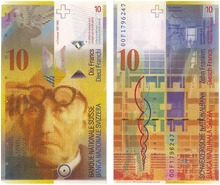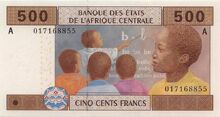
A Swiss franc note
The franc (German: Frank; Italian: franco) is the name of several currency units, most notably the Swiss franc, which is currently a major-world currency, and the French franc, the currency of France before the euro. The name is believed to be derived from the Latin inscription francorum rex, meaning "King of the Franks", or from the French franc, meaning "free" and "Frank".
Countries that currently use the franc include Switzerland, Liechtenstein, and several former colonies of France and Belgium. Before the euro was introduced, the franc was used in France, Belgium, Luxembourg, Andorra, and Monaco.
Typically, one franc is subdivided into 100 centimes.
History[]
Europe[]

A franc à cheval coin from 1360.
The franc was originally a French gold coin minted in 1360 on the occasion of King John II's release after being held by the English for four years after his capture at the Battle of Poitiers. The coin, known as the franc à cheval, had a value equal to one livre tournois. From 1575 to 1641, franc became the name of a number of silver coins. The franc finally became the national currency of France from 1795 to 1999 (franc coins and notes remained legal tender until 2002).
In 1798, Switzerland, under French control, began to issue its own franc coins, replacing the previous cantonal currencies. After the Act of Mediation was issued in 1803, the Swiss cantons began to issue separate currencies once again, some of which were denominated in francs (or franken). The current Swiss franc was first issued in 1850 and is currently one of the world's strongest currencies. It is used in Switzerland and Liechtenstein, though the latter retains the ability to mint its own currency, the Liechtenstein frank, which it does from time to time for commemorative purposes.

A Belgian franc coin.
Following its independence from the Kingdom of the Netherlands, the Kingdom of Belgium adopted the Belgian franc in 1832, which had a value equivalent to the French franc. It was followed by Luxembourg adopting the Luxembourgish franc in 1848. Beginning in 1944, the Belgian franc shared a fixed exchange rate with the Luxembourgish franc, at a rate of 1:1. In addition, Belgian francs were considered legal tender within Luxembourg, and Luxembourg francs were legal tender in Belgium. It remained like this until 1999, when both currencies were replaced by the euro.
In 1837, the Monegasque franc of Monaco and Andorra was introduced, with a value equivalent to the French franc. Coins of this currency were issued until 1999. From 1926 to 1939, Albanian franga coins and notes were issued. Also, from 1947 to 1959, the Saar Protectorate and Saarland issued a currency denominated in francs.
Belgian and French influence[]

The franc is used in many African countries.
Most of the countries that used or currently use franc-denominated currencies were formerly Belgian or French colonies. After the Belgian and French franc currencies were introduced within their respective countries, they began to be issued in their respective territories. Subsequently, a number of these territories began introducing their own currencies based on the franc, including the French territories of French Equatorial Africa, French Guiana, Réunion, and the Belgian territories of Congo and Ruanda-Urundi. In addition, the Dominican Republic introduced the franco in 1891, intending to join the Latin Monetary Union, which was formed by Belgium, France, Italy, and Switzerland in 1865.
In 1945, the CFA franc was introduced and is currently circulating in twelve former French colonies, Guinea-Bissau, and Equatorial Guinea. A similar currency, the CFP franc, is used by the French overseas collectivities of French Polynesia, New Caledonia, and Wallis and Futuna.
Current status[]

Currently uses the franc
Formerly used the franc
A total of twenty-two countries and three territories currently use a currency denominated in francs. Twenty of the twenty-two countries using the franc are located in Africa, while the three territories using the franc are currently under possession of the French Republic. The French territories of French Polynesia, New Caledonia, and Wallis and Futuna currently use the CFP franc. Fourteen African countries currently use the CFA franc and six other African countries issue their own franc currencies. Today, Liechtenstein and Switzerland are the only European countries to still use the franc, and at the moment, neither have plans to replace their currencies with the euro.
List of franc currencies[]
- Main article: Franc/Index
| Currency | Countries | ISO 4217 code | Years | |||
|---|---|---|---|---|---|---|
| Belgian franc | BEF |
| ||||
| Burundian franc | BIF |
| ||||
| Central African CFA franc | XAF |
| ||||
| CFP franc | XPF |
| ||||
| Congolese franc | CDF |
| ||||
| Comorian franc | KMF |
| ||||
| Djiboutian franc | DJF |
| ||||
| French franc | FRF |
| ||||
| Guinean franc | GNF |
| ||||
| Rwandan franc | RWF |
| ||||
| Swiss franc | CHF |
| ||||
| West African CFA franc | XOF |
|
